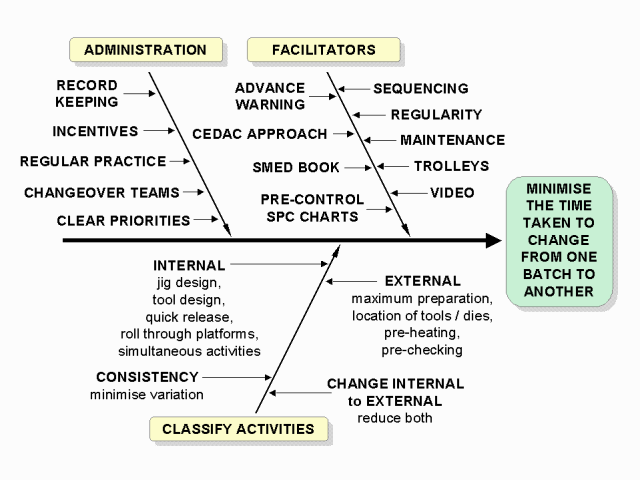
Lean and CHANGEOVER REDUCTION

The prime reason for changeover reduction in Lean is for flexibility and reduced batch sizes, leading to lead-time competitiveness. Improved changeover also, surprisingly, leads to improved quality through consistent repetition. A less good reason is to increase capacity, especially if it leads to overproduction.
Note that changeover is defined as the time from the last piece of one batch to the first good piece of the next batch. In some cases the limitation on batch sizes is not the internal changeover time (when the machine is stopped) but the external time for changeover preparation. So both need to be reduced as well as the time for adjustment and inspection.
Note also that changeover reduction is not limited to machine changeover. Line changeover, vehicle load and unload, maintenance operations, and many office operations are also relevant.
Consistency is a big issue. It is not much good having a changeover that sometimes takes 10 minutes but at other times takes 30 minutes. Sometimes, to achieve schedule adherence, it is more important to be consistent than quick but variable. Standardisation should certainly be a goal.
The classic analogy is with a grand prix pit stop. The same principles apply.
Shingo's classic single-minute exchange of die (SMED) approach is to flowchart the changeover and to classify into external and internal activities. See if any internal activities can be done externally.
Do the maximum amount of preparation before the machine is stopped. This includes locating tools and dies on trolleys, colour coding to avoid confusion, locating frequently used dies nearer to machines, pre-heating and pre-checking (and post changeover checking also to maximise the time available).
Many internal improvements involve the use of simple, though sometimes sophisticated devices:
Remember the quality side - incorporate failsafing devices, offline checks, and testing procedures (sometimes it is the sampling that takes the longest time).
The process should be mapped and the critical path determined. A spaghetti diagram of operator movements is useful.
Correct sequencing of changeovers, from major to minor, from dark colour to light may help. So may regularity where a changeover takes place at approximately the same time each day or week. (Dies are always ready, so is the forklift, so are the parts to be processed, etc.,). Preventive maintenance of tools, dies, and machines is essential to retain changeover consistency. Trolleys, on which are placed, by shadowboard and colour coded, all necessary tools and dies, preferably at the correct height, are useful. Every changeover should be videod with a time lapse camera.
Advance warning means having a clear signal (lights, audio) when a changeover is due to warn the changeover team and the forklift driver. Cause and Effect diagrams with addition of cards (CEDAC) should be used to record past achievements and tasks still to be done. Pre-control SPC charts are a good way to get quickly onto defect prevention. For more detailed information, Shingo's SMED book is the bible on changeover.
An aspect frequently ignored is to chart every changeover time on a run diagram. This helps encourage consistency and to trace sources of problems. Team members should feel free to write ideas and memos on the chart - use rather than appearance is preferred. Incentives are both financial and non-financial. Although output incentives are not compatible with Lean, consistency and achievement may well be rewarded. Nono-financial reward and recognition is necessary to retain good performance. As in a grand prix racing team, practice makes perfect; you don't have to make parts to practice and perfect a changeover. Also as in a grand prix, teams should be used to perform critical changeovers. Finally, changeovers should enjoy clear priority over support activities; never delay a changeover for a non-customer critical activity.